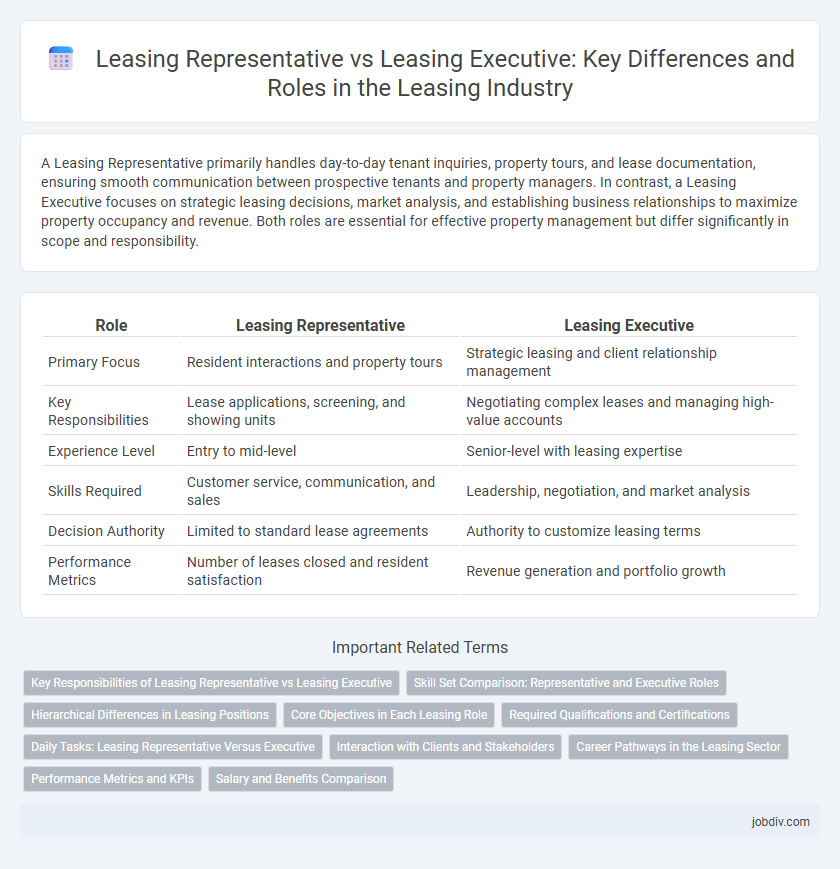A Leasing Representative primarily handles day-to-day tenant inquiries, property tours, and lease documentation, ensuring smooth communication between prospective tenants and property managers. In contrast, a Leasing Executive focuses on strategic leasing decisions, market analysis, and establishing business relationships to maximize property occupancy and revenue. Both roles are essential for effective property management but differ significantly in scope and responsibility.
Table of Comparison
| Role | Leasing Representative | Leasing Executive |
|---|---|---|
| Primary Focus | Resident interactions and property tours | Strategic leasing and client relationship management |
| Key Responsibilities | Lease applications, screening, and showing units | Negotiating complex leases and managing high-value accounts |
| Experience Level | Entry to mid-level | Senior-level with leasing expertise |
| Skills Required | Customer service, communication, and sales | Leadership, negotiation, and market analysis |
| Decision Authority | Limited to standard lease agreements | Authority to customize leasing terms |
| Performance Metrics | Number of leases closed and resident satisfaction | Revenue generation and portfolio growth |
Key Responsibilities of Leasing Representative vs Leasing Executive
Leasing Representatives primarily handle tenant inquiries, conduct property tours, process rental applications, and facilitate lease signings, ensuring customer satisfaction and lease compliance. Leasing Executives focus on strategic lease management, overseeing leasing operations, negotiating complex lease agreements, and developing marketing strategies to maximize occupancy and revenue. Both roles require strong communication skills and knowledge of leasing regulations, but Leasing Executives typically manage higher-level responsibilities and leadership functions within leasing departments.
Skill Set Comparison: Representative and Executive Roles
Leasing Representatives primarily excel in customer service, lead generation, and property tours, demonstrating strong communication and interpersonal skills essential for initial client engagement. Leasing Executives possess advanced negotiation abilities, strategic sales acumen, and expertise in closing high-value lease agreements, reflecting their role in driving revenue growth and managing key accounts. Both roles require familiarity with leasing software and market analysis, but Leasing Executives typically demand deeper analytical skills and leadership experience.
Hierarchical Differences in Leasing Positions
Leasing Representatives typically handle day-to-day leasing activities, including tenant inquiries and lease documentation, operating at an entry or mid-level position within the leasing hierarchy. Leasing Executives hold higher-ranking roles with broader responsibilities such as strategic client acquisition, portfolio management, and leading leasing teams. The hierarchical difference reflects the scope of authority and decision-making power, with Leasing Executives overseeing multiple properties or regions, whereas Leasing Representatives focus on individual property leasing operations.
Core Objectives in Each Leasing Role
Leasing Representatives primarily focus on tenant acquisition and lease administration, ensuring prospective tenants understand lease terms and complete application processes efficiently. Leasing Executives emphasize strategic portfolio management and revenue optimization by developing relationships with key clients and overseeing lease negotiations to maximize occupancy rates. Both roles align to drive rental growth, but Leasing Representatives handle day-to-day tenant interactions, while Leasing Executives focus on broader market positioning and client retention strategies.
Required Qualifications and Certifications
Leasing Representatives typically require a high school diploma or equivalent, with strong customer service skills and basic knowledge of leasing contracts, while Leasing Executives often hold a bachelor's degree in business, real estate, or a related field, combined with advanced sales experience and leadership capabilities. Certifications such as Certified Apartment Leasing Professional (CALP) benefit Leasing Representatives by enhancing leasing knowledge, whereas Leasing Executives may pursue Certified Property Manager (CPM) or National Apartment Leasing Professional (NALP) certifications to demonstrate expertise in property management and executive leasing strategies. Both roles require familiarity with Fair Housing laws and local real estate regulations to ensure compliant leasing practices.
Daily Tasks: Leasing Representative Versus Executive
Leasing Representatives primarily handle daily tasks such as showing properties, conducting tenant screenings, processing lease applications, and assisting with move-ins to ensure smooth occupancy. Leasing Executives oversee broader operational responsibilities including managing leasing teams, developing marketing strategies, analyzing leasing metrics, and coordinating with property management to optimize revenue. Both roles prioritize tenant relations, but Leasing Executives focus more on strategic planning and leadership within leasing operations.
Interaction with Clients and Stakeholders
Leasing Representatives primarily engage directly with prospective tenants, guiding them through property tours, application processes, and lease agreements to ensure a personalized client experience. Leasing Executives interact with a broader range of stakeholders, including property owners, management teams, and marketing departments, to strategize leasing goals and optimize occupancy rates. Both roles require strong communication skills, but Leasing Executives focus more on high-level negotiation and relationship management while Leasing Representatives emphasize day-to-day client interactions.
Career Pathways in the Leasing Sector
Leasing Representatives typically handle day-to-day tenant interactions and property showings, serving as entry-level professionals focused on lease agreements and customer service. Leasing Executives, often promoted from Representative roles, manage higher-level responsibilities such as strategic marketing, client retention, and development of leasing policies. Career pathways in the leasing sector commonly progress from Leasing Representative to Leasing Executive, with opportunities to advance into property management or real estate development roles.
Performance Metrics and KPIs
Leasing Representatives are primarily evaluated on metrics such as lease conversion rates, number of showings conducted, and responsiveness to tenant inquiries, directly impacting occupancy levels. Leasing Executives focus on higher-level KPIs including sales volume, revenue growth, and strategic account management efficiency, reflecting their role in driving business expansion. Both positions utilize resident satisfaction scores and lease renewal rates as critical indicators of sustained performance and tenant retention.
Salary and Benefits Comparison
Leasing Representatives typically earn a base salary ranging from $35,000 to $50,000 annually, while Leasing Executives often command higher salaries between $50,000 and $75,000, reflecting greater experience and responsibility. Leasing Executives generally receive enhanced benefits packages, including performance bonuses, health insurance, and stock options, which are less common for Leasing Representatives. The salary and benefits gap underscores the progression opportunities within leasing careers, emphasizing the financial incentives tied to executive roles.
Leasing Representative vs Leasing Executive Infographic

 jobdiv.com
jobdiv.com